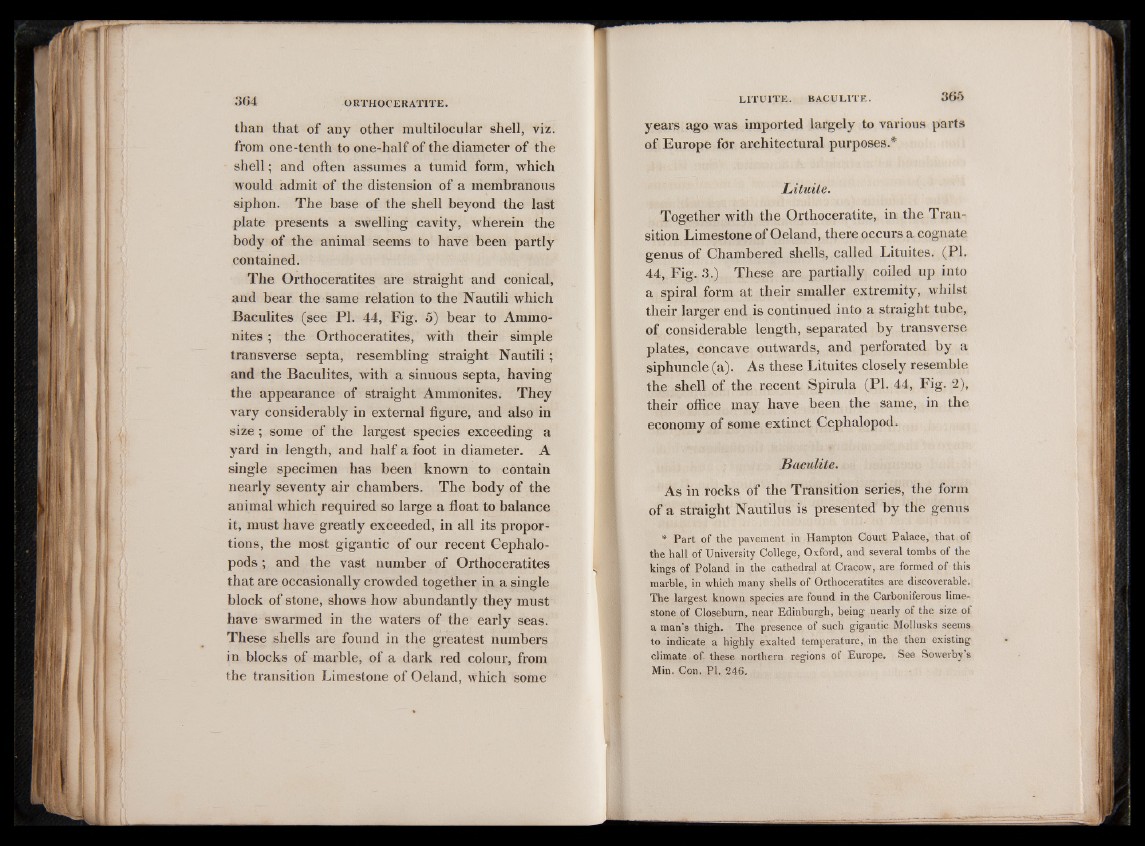
than that of any other multilocular shell, viz.
from one-tenth to one-half of the diameter of the
shell; and often assumes a tumid form, which
would admit of the distension of a membranous
siphon. The base of the shell beyond the last
plate presents a swelling cavity, wherein the
body of the animal seems to have been partly
contained.
The Orthoceratites are straight and conical,
and bear the same relation to the Nautili which
Baculites (see PI. 44, Fig. 5) bear to Ammonites
; the Orthoceratites, with their simple
transverse septa, resembling straight Nautili;
and the Baculites, with a sinuous septa, having
the appearance of straight Ammonites. They
vary considerably in external figure, and also in
size; some of the largest species exceeding a
yard in length, and half a foot in diameter. A
single specimen has been known to contain
nearly seventy air chambers. The body of the
animal which required so large a float to balance
it, must have greatly exceeded, in all its proportions,
the most gigantic of our recent Cephalo-
pods ; and the vast number of Orthoceratites
that are occasionally crowded together in a single
block of stone, shows how abundantly they must
have swarmed in the waters of the early seas.
These shells are found in the greatest numbers
in blocks of marble, of a dark red colour, from
the transition Limestone of Oeland, which some
years ago was imported largely to various parts
of Europe for architectural purposes.*
Lituite.
Together with the Orthoceratite, in the Transition
Limestone of Oeland, there occurs a cognate
genus of Chambered shells, called Lituites. (PI.
44, Fig. 3.) These are partially coiled up into
a spiral form at their smaller extremity, whilst
their larger end is continued into a straight tube,
of considerable length, separated by transverse
plates, concave outwards, and perforated by a
siphuncle (a). As these Lituites closely resemble
the shell of the recent Spirula (PI. 44, Fig. 2),
their office may have been the same, in the
economy of some extinct Cephalopod.
Saculite.
As in rocks of the Transition series, the form
of a straight Nautilus is presented by the genus
* Part of the pavement in Hampton Court Palace, that of
the hall of University College, Oxford, and several tombs of the
kings of Poland in the cathedral at Cracow, are formed of this
marble, in which many shells of Orthoceratites are discoverable.
The largest known species are found in the Carboniferous limestone
of Closeburn, near Edinburgh, being nearly of the size of
a man’s thigh. The presence of such gigantic Mollusks seems
to indicate a highly exalted temperature, in the then existing
climate of these northern regions of Europe. See Sowerby’s
Min. Con. PI. 246.